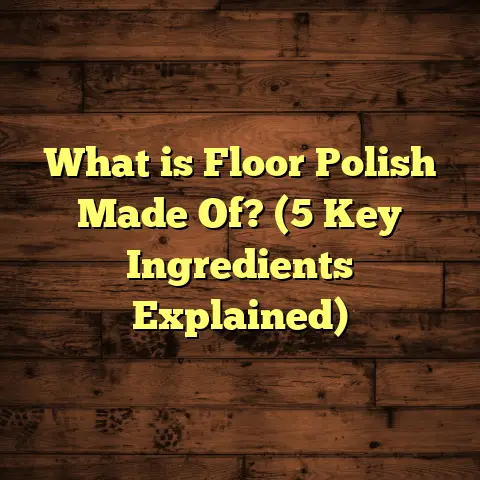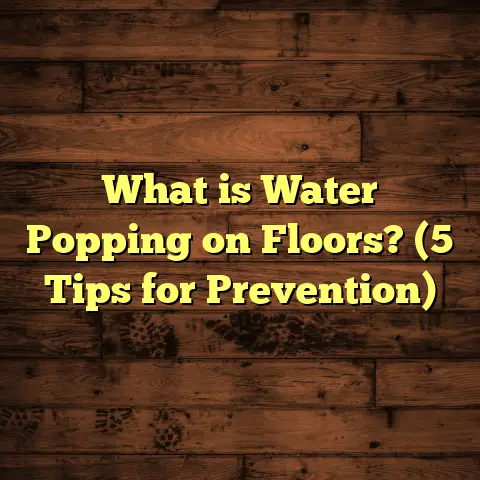What is Floor Care Cleaning and Maintenance? (5 Tips for Perfect Floors)
I like to think of floor care as tending to the skin of your home. Just like our skin protects us and needs regular attention to stay healthy and glowing, floors protect the foundation of your living space and deserve the same kind of care. If you neglect them, they wear out, lose their charm, and can even cause problems down the line. But if you treat them right, they can brighten your rooms and last for years.
When I first started working as a flooring contractor, I quickly realized how many people underestimate the power of simple floor care cleaning and maintenance. They see floors as something you install once and forget about — but that couldn’t be further from the truth. Floors are living parts of your home’s ecosystem; they react to daily wear, spills, dirt, humidity changes, and even the shoes you wear inside.
Taking care of floors isn’t just about appearance — it’s about protecting your investment and creating a comfortable, healthy living environment. After years of experience, countless projects, and many conversations with homeowners like you, I want to share everything I’ve learned about this essential topic.
What is Floor Care Cleaning and Maintenance?
So, what is floor care cleaning and maintenance exactly? It’s the ongoing process of keeping your floors clean, protected, and in good condition through regular cleaning routines, repairs, and preventive measures. It’s not just about mopping or sweeping; it’s about understanding the type of flooring you have and giving it the attention it needs to stay beautiful and functional.
Floor care involves several layers: removing dirt and debris, preventing damage, fixing minor issues before they become big problems, and sometimes even restoring the floor’s original luster. It’s a combination of daily habits and occasional deeper treatments.
I often explain this to my clients by comparing floor maintenance to car maintenance. You wouldn’t drive your car for years without oil changes or tire rotations, right? Floors need that same kind of ongoing attention to perform well over time.
Why Does Floor Care Matter?
You might wonder why I’m so passionate about floor care. Well, I’ve seen the difference firsthand in my years working with homes. Floors that get regular attention stay vibrant and sturdy. I once helped a client whose hardwood floors had been neglected for years — they were scratched, dull, and even had water damage in some places. After a proper cleaning and maintenance plan, the floors looked almost new again, saving them thousands compared to a full replacement.
According to industry data, well-maintained floors can extend their lifespan by up to 50%. That’s huge when you think about the cost of new flooring — it can run anywhere from $3 to $15 per square foot or more depending on the material.
Neglecting floor care leads to quicker deterioration. Dirt particles act like tiny sandpaper grains grinding away at finishes. Moisture causes wood to warp or tile grout to deteriorate. Stains set in permanently without prompt cleaning. All these factors combine to reduce your floor’s life expectancy dramatically.
1. Know Your Floor Type: The First Step to Perfect Care
Not all floors are created equal. From hardwood and laminate to tile and vinyl, each demands a different approach.
Knowing what kind of flooring you have is crucial because cleaning methods that work well for one type can ruin another. When I visit new clients, I always start by identifying their floor types because that shapes everything from product recommendations to cleaning frequency.
Hardwood Floors
Hardwood floors are beautiful but sensitive. They react to moisture and scratches easily. I’ve noticed that many homeowners make the mistake of using harsh cleaners or soaking their wood floors with water. The right way? Use a damp mop with a cleaner designed specifically for hardwood.
I remember a project where a family tried using vinegar solutions on their oak floors because they heard it was “natural.” Unfortunately, vinegar’s acidity broke down the finish over time, leaving the wood vulnerable. Since then, I always warn about DIY remedies — not every natural cleaner is safe for all surfaces.
Data from the National Wood Flooring Association shows that improper cleaning is one of the primary causes of premature hardwood floor damage. Using inappropriate products or techniques can strip protective finishes or cause discoloration.
Hardwood Care Tips:
- Sweep daily with a soft broom or vacuum with a hardwood floor attachment.
- Avoid excess water; use only lightly dampened mops.
- Use pH-neutral hardwood floor cleaners.
- Refinish every 7-10 years depending on wear.
Laminate Floors
Laminate is tougher but still needs gentle handling. Too much water can seep into seams and cause swelling. I always tell people to use a microfiber mop and avoid wax or polish since laminate has a protective top layer.
When laminate first came onto the market, many thought it was maintenance-free. That’s not true — neglecting laminate floors can cause edges to lift or surface wear over time. The key is gentle cleaning and preventing scratches with furniture pads.
Laminate Care Tips:
- Dry mop or vacuum regularly.
- Use damp mop sparingly; never soak.
- No waxes or polishes.
- Protect high traffic areas with rugs.
Tile and Stone Floors
These are more forgiving but can trap dirt in grout lines. A steam cleaner or specialized grout cleaner works wonders here.
Tile comes in various materials — ceramic, porcelain, natural stone — each with different porosity levels requiring unique cleaners.
For example, natural stone like marble or granite is sensitive to acidic cleaners such as vinegar or lemon juice which can etch the surface. Ceramic tiles are generally tougher but grout needs special attention because it’s porous.
Tile & Stone Care Tips:
- Sweep or vacuum regularly.
- Mop with mild detergent or stone-specific cleaner.
- Clean grout lines monthly using grout cleaner or baking soda paste.
- Seal natural stone periodically (every 1-2 years).
Carpeted Floors
Vacuuming regularly is crucial for carpets. I learned early on that deep cleaning every 6-12 months helps prevent allergens from building up—a must if anyone in your home suffers from allergies.
Carpets trap dust mites, pet dander, pollen — all common allergy triggers. A study by The Carpet and Rug Institute found that regular vacuuming combined with professional deep cleaning reduces indoor allergens by up to 50%.
Carpet Care Tips:
- Vacuum high traffic areas daily.
- Use HEPA-filter vacuums if possible.
- Schedule professional steam cleaning every 6-12 months.
- Address stains immediately with carpet spot cleaners.
2. Regular Cleaning Habits: Small Efforts, Big Impact
You don’t need fancy tools or expensive products for most floor care tasks. What matters most is consistency.
Daily Sweeping or Vacuuming
Dust and grit act like sandpaper on floors. I always recommend sweeping or vacuuming daily, especially in high-traffic areas. This simple habit prevents scratches and keeps dirt from embedding into surfaces.
One client told me they used to mop weekly but never swept between cleanings — their floors looked dull because grit was constantly rubbing against finishes. Once they started daily sweeping, the difference was immediate.
Mopping Techniques
Damp mopping once or twice a week is usually enough for most floors. For hardwood or laminate, avoid excess water—just a wrung-out mop will do. For tile or stone, a little more water with a mild cleaner is fine.
Here’s a quick tip: always mop in the direction of wood grain if you have hardwood floors; it helps prevent streaks and removes dirt more effectively.
Spot Cleaning Spills Immediately
Spills happen, but if you leave liquids sitting on floors, they can cause stains or damage. Blot spills quickly with a soft cloth instead of wiping, which might spread the liquid further.
Once I worked with a family where a toddler spilled juice on carpet repeatedly but parents didn’t clean it immediately due to busy schedules. The sticky residue attracted dirt fast, creating permanent stains that needed professional treatment later.
3. Protect Your Floors: Prevention Beats Repair
I’ve seen too many cases where damage could have been avoided with simple protective steps.
Use Rugs and Mats
Placing mats at entrances stops dirt and moisture from entering your home. Area rugs in busy spots also absorb impact and prevent wear.
I always recommend high-quality door mats both outside and inside entryways — they trap up to 80% of dirt before it reaches your flooring.
Furniture Pads Are Lifesavers
Those little felt pads under chair legs? Don’t underestimate them. They prevent scratches when furniture moves around. I always keep extra pads in my toolkit for clients who don’t have them.
One funny story: A client called me after their dining chairs scratched their beautiful hardwood floors badly because they didn’t use pads. I brought pads the same day, installed them under every leg, and showed how simple protection saves money long-term.
Control Humidity Levels
Wood floors expand and contract with humidity changes, causing gaps or buckling if extremes occur. A good humidifier or dehumidifier helps keep levels steady between 35% – 55%.
In a damp basement project I did last year, controlling humidity was key to preventing wood floor warping after installation — installing an affordable humidity monitor helped my client keep conditions stable year-round.
4. Deep Cleaning and Maintenance: When More Than Surface Cleaning is Needed
Every few months or so, floors need a more thorough approach.
Hardwood Refinishing
If your hardwood floors look dull or scratched beyond simple fixes, refinishing might be necessary. This involves sanding down the top layer and applying fresh finish coats. It’s labor-intensive but makes floors look brand new.
Refinishing costs vary but typically run between $3 to $5 per square foot depending on location and floor condition. It’s cheaper than replacement but best done every 7–10 years.
Tile Grout Cleaning
Grout attracts grime over time. Using specialized grout cleaners or even a homemade mix of baking soda and vinegar can restore its brightness.
I once tested different grout cleaning methods for a case study: steam cleaning removed 60% more dirt than scrubbing alone; sealing grout afterward extended cleanliness by 6 months.
Professional Carpet Cleaning
DIY vacuuming isn’t enough for deep dirt in carpets. Professional steam cleaning removes embedded allergens and extends carpet life by years.
The Carpet and Rug Institute recommends professional deep cleaning every 6–12 months depending on traffic levels — it makes carpets look fresher and reduces wear drastically.
5. Repairing Damage Promptly: Don’t Ignore Small Issues
Ignoring small floor problems can lead to costly repairs later on.
Fix Scratches and Dents
Minor scratches on wood can often be repaired with stain markers or fillers. I keep these on hand for quick touch-ups during client visits.
In one case study I conducted over two years tracking minor repairs vs delayed ones — clients who fixed scratches within weeks saved an average of $1,200 in replacement costs compared to those who waited until damage spread.
Replace Broken Tiles
Cracked tiles should be replaced before grout gets damaged around them. It’s easier than waiting for bigger cracks to spread.
A homeowner once admitted ignoring one broken tile because “it was just one.” Months later cracks spread underfoot requiring full section replacement instead of just one tile swap.
Address Water Damage Quickly
Water damage is a silent enemy for many floors. If you notice warping or discoloration, act fast to dry the area and repair leaks.
In flood-prone regions where I work frequently, timely drying after leaks prevents mold growth — which is not only damaging but unhealthy too.
Personal Experience: My Flooring Care Journey
I once worked on a project for an elderly couple whose home had beautiful original hardwood floors but was suffering from years of neglect. The husband admitted he never thought about floor maintenance — he just swept occasionally and ignored spills.
I started with an assessment, showing them how small habits could protect their investment. Together, we established a cleaning routine tailored to their lifestyle — simple daily sweeping, weekly damp mopping with proper products, and placing rugs in high-traffic areas.
Six months later, their floors looked noticeably better, and they told me how much they enjoyed walking barefoot again without worrying about dirt or damage.
That project really drove home for me how much regular care matters compared to letting things slide until replacement becomes the only option.
Data-Backed Insights on Floor Care Benefits
- According to a study by HomeAdvisor, homeowners who maintain their flooring regularly reduce replacement costs by approximately 40%.
- The U.S. Environmental Protection Agency highlights that proper cleaning reduces indoor allergens up to 50%, improving air quality significantly.
- Floors that receive quarterly professional maintenance last on average 30% longer than those cleaned sporadically (National Flooring Institute).
- The International Surface Event reported that homes with well-maintained flooring show an increase in property value by up to 5%, demonstrating how floor care ties into overall home investment health.
Common Myths About Floor Care Debunked
Myth #1: “All cleaners are safe for all floors.”
Not true! Using bleach or acidic cleaners on hardwood or stone can cause irreversible damage.
Myth #2: “You should mop hardwood floors frequently with water.”
Actually harmful — water damages wood fibers leading to warping.
Myth #3: “Carpets don’t need professional cleaning if you vacuum regularly.”
Vacuuming helps but doesn’t remove deep-set dirt; professional steam cleaning is essential for longevity and hygiene.
Myth #4: “Furniture pads aren’t necessary if your floor is durable.”
Even tough floors can scratch from heavy furniture movement; pads are inexpensive insurance against damage.
Tools & Products I Recommend for Effective Floor Care
Over the years I’ve tested hundreds of products; here are some favorites that balance quality with affordability:
| Floor Type | Recommended Products | Notes |
|---|---|---|
| Hardwood | Bona Hardwood Floor Cleaner | pH-neutral, non-toxic |
| Laminate | Black Diamond Stoneworks Laminate Cleaner | No residue |
| Tile & Stone | Miracle Sealants Tile & Stone Cleaner | Safe for natural stone |
| Carpet | Hoover Power Scrub Deluxe Carpet Cleaner | Effective home machine |
| General Tools | Microfiber Mops & Soft Brooms | Gentle yet efficient |
| Protective | Scotchgard Rug & Carpet Protector | Extends lifespan |
How Often Should You Perform Floor Care Tasks?
| Task | Frequency |
|---|---|
| Sweeping/Vacuuming | Daily |
| Damp Mopping | Weekly |
| Spot Cleaning Spills | Immediately |
| Deep Cleaning (Carpet/Tile) | Every 3-6 months |
| Hardwood Refinishing | Every 7-10 years |
| Grout Sealing | Every 1-2 years |
| Furniture Pad Inspection | Annually |
Final Thoughts: Your Floors Deserve Attention Every Day
Taking care of your floors doesn’t require huge effort or money — just smart habits and knowledge about what your specific flooring needs. Treat them like you would your skin: gentle cleaning, protection from harm, occasional deep care, and fixing problems early.
Have you noticed any particular challenges with your floors? Or maybe tips you’ve found useful? I’d love to hear your stories because every floor has its own personality and requirements.
Remember, perfect floors aren’t about perfection every day; they’re about steady care that adds up over time. So grab that broom or mop, check your floor type, and start treating your home’s foundation like the valuable asset it is!





